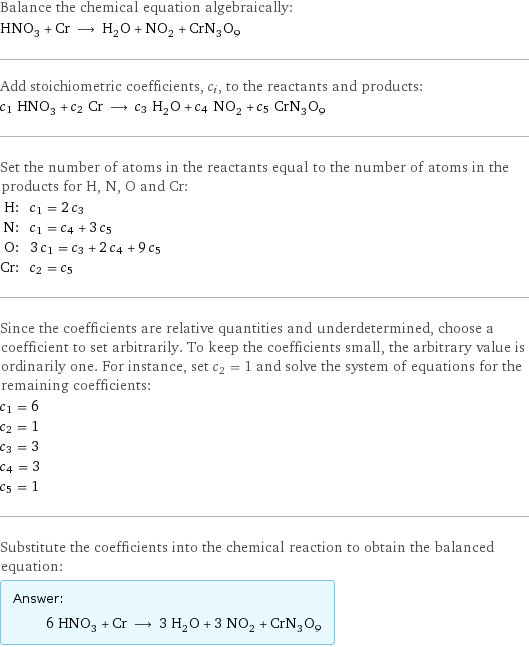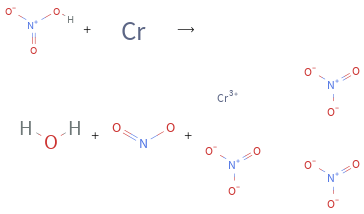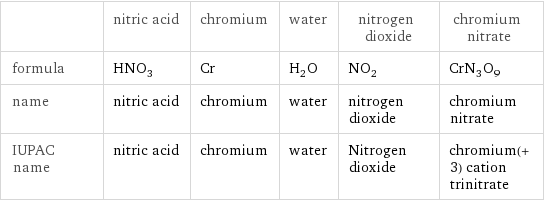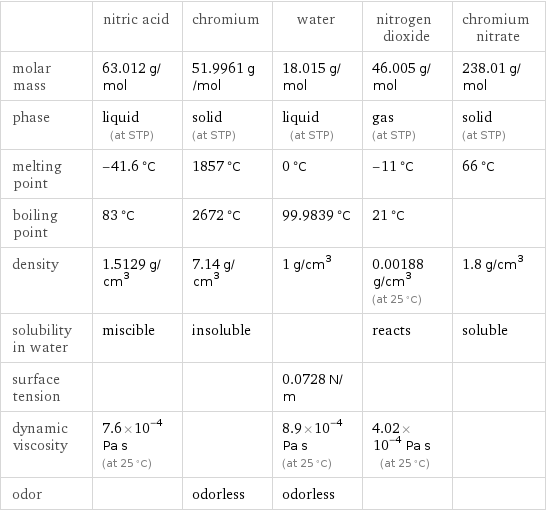Input interpretation

HNO_3 nitric acid + Cr chromium ⟶ H_2O water + NO_2 nitrogen dioxide + CrN_3O_9 chromium nitrate
Balanced equation

Balance the chemical equation algebraically: HNO_3 + Cr ⟶ H_2O + NO_2 + CrN_3O_9 Add stoichiometric coefficients, c_i, to the reactants and products: c_1 HNO_3 + c_2 Cr ⟶ c_3 H_2O + c_4 NO_2 + c_5 CrN_3O_9 Set the number of atoms in the reactants equal to the number of atoms in the products for H, N, O and Cr: H: | c_1 = 2 c_3 N: | c_1 = c_4 + 3 c_5 O: | 3 c_1 = c_3 + 2 c_4 + 9 c_5 Cr: | c_2 = c_5 Since the coefficients are relative quantities and underdetermined, choose a coefficient to set arbitrarily. To keep the coefficients small, the arbitrary value is ordinarily one. For instance, set c_2 = 1 and solve the system of equations for the remaining coefficients: c_1 = 6 c_2 = 1 c_3 = 3 c_4 = 3 c_5 = 1 Substitute the coefficients into the chemical reaction to obtain the balanced equation: Answer: | | 6 HNO_3 + Cr ⟶ 3 H_2O + 3 NO_2 + CrN_3O_9
Structures

+ ⟶ + +
Names

nitric acid + chromium ⟶ water + nitrogen dioxide + chromium nitrate
Equilibrium constant
![Construct the equilibrium constant, K, expression for: HNO_3 + Cr ⟶ H_2O + NO_2 + CrN_3O_9 Plan: • Balance the chemical equation. • Determine the stoichiometric numbers. • Assemble the activity expression for each chemical species. • Use the activity expressions to build the equilibrium constant expression. Write the balanced chemical equation: 6 HNO_3 + Cr ⟶ 3 H_2O + 3 NO_2 + CrN_3O_9 Assign stoichiometric numbers, ν_i, using the stoichiometric coefficients, c_i, from the balanced chemical equation in the following manner: ν_i = -c_i for reactants and ν_i = c_i for products: chemical species | c_i | ν_i HNO_3 | 6 | -6 Cr | 1 | -1 H_2O | 3 | 3 NO_2 | 3 | 3 CrN_3O_9 | 1 | 1 Assemble the activity expressions accounting for the state of matter and ν_i: chemical species | c_i | ν_i | activity expression HNO_3 | 6 | -6 | ([HNO3])^(-6) Cr | 1 | -1 | ([Cr])^(-1) H_2O | 3 | 3 | ([H2O])^3 NO_2 | 3 | 3 | ([NO2])^3 CrN_3O_9 | 1 | 1 | [CrN3O9] The equilibrium constant symbol in the concentration basis is: K_c Mulitply the activity expressions to arrive at the K_c expression: Answer: | | K_c = ([HNO3])^(-6) ([Cr])^(-1) ([H2O])^3 ([NO2])^3 [CrN3O9] = (([H2O])^3 ([NO2])^3 [CrN3O9])/(([HNO3])^6 [Cr])](../image_source/c811430e7b331675d6db5d7a50f14efa.png)
Construct the equilibrium constant, K, expression for: HNO_3 + Cr ⟶ H_2O + NO_2 + CrN_3O_9 Plan: • Balance the chemical equation. • Determine the stoichiometric numbers. • Assemble the activity expression for each chemical species. • Use the activity expressions to build the equilibrium constant expression. Write the balanced chemical equation: 6 HNO_3 + Cr ⟶ 3 H_2O + 3 NO_2 + CrN_3O_9 Assign stoichiometric numbers, ν_i, using the stoichiometric coefficients, c_i, from the balanced chemical equation in the following manner: ν_i = -c_i for reactants and ν_i = c_i for products: chemical species | c_i | ν_i HNO_3 | 6 | -6 Cr | 1 | -1 H_2O | 3 | 3 NO_2 | 3 | 3 CrN_3O_9 | 1 | 1 Assemble the activity expressions accounting for the state of matter and ν_i: chemical species | c_i | ν_i | activity expression HNO_3 | 6 | -6 | ([HNO3])^(-6) Cr | 1 | -1 | ([Cr])^(-1) H_2O | 3 | 3 | ([H2O])^3 NO_2 | 3 | 3 | ([NO2])^3 CrN_3O_9 | 1 | 1 | [CrN3O9] The equilibrium constant symbol in the concentration basis is: K_c Mulitply the activity expressions to arrive at the K_c expression: Answer: | | K_c = ([HNO3])^(-6) ([Cr])^(-1) ([H2O])^3 ([NO2])^3 [CrN3O9] = (([H2O])^3 ([NO2])^3 [CrN3O9])/(([HNO3])^6 [Cr])
Rate of reaction
![Construct the rate of reaction expression for: HNO_3 + Cr ⟶ H_2O + NO_2 + CrN_3O_9 Plan: • Balance the chemical equation. • Determine the stoichiometric numbers. • Assemble the rate term for each chemical species. • Write the rate of reaction expression. Write the balanced chemical equation: 6 HNO_3 + Cr ⟶ 3 H_2O + 3 NO_2 + CrN_3O_9 Assign stoichiometric numbers, ν_i, using the stoichiometric coefficients, c_i, from the balanced chemical equation in the following manner: ν_i = -c_i for reactants and ν_i = c_i for products: chemical species | c_i | ν_i HNO_3 | 6 | -6 Cr | 1 | -1 H_2O | 3 | 3 NO_2 | 3 | 3 CrN_3O_9 | 1 | 1 The rate term for each chemical species, B_i, is 1/ν_i(Δ[B_i])/(Δt) where [B_i] is the amount concentration and t is time: chemical species | c_i | ν_i | rate term HNO_3 | 6 | -6 | -1/6 (Δ[HNO3])/(Δt) Cr | 1 | -1 | -(Δ[Cr])/(Δt) H_2O | 3 | 3 | 1/3 (Δ[H2O])/(Δt) NO_2 | 3 | 3 | 1/3 (Δ[NO2])/(Δt) CrN_3O_9 | 1 | 1 | (Δ[CrN3O9])/(Δt) (for infinitesimal rate of change, replace Δ with d) Set the rate terms equal to each other to arrive at the rate expression: Answer: | | rate = -1/6 (Δ[HNO3])/(Δt) = -(Δ[Cr])/(Δt) = 1/3 (Δ[H2O])/(Δt) = 1/3 (Δ[NO2])/(Δt) = (Δ[CrN3O9])/(Δt) (assuming constant volume and no accumulation of intermediates or side products)](../image_source/536ca80921d5b1c7e2e53505089c8712.png)
Construct the rate of reaction expression for: HNO_3 + Cr ⟶ H_2O + NO_2 + CrN_3O_9 Plan: • Balance the chemical equation. • Determine the stoichiometric numbers. • Assemble the rate term for each chemical species. • Write the rate of reaction expression. Write the balanced chemical equation: 6 HNO_3 + Cr ⟶ 3 H_2O + 3 NO_2 + CrN_3O_9 Assign stoichiometric numbers, ν_i, using the stoichiometric coefficients, c_i, from the balanced chemical equation in the following manner: ν_i = -c_i for reactants and ν_i = c_i for products: chemical species | c_i | ν_i HNO_3 | 6 | -6 Cr | 1 | -1 H_2O | 3 | 3 NO_2 | 3 | 3 CrN_3O_9 | 1 | 1 The rate term for each chemical species, B_i, is 1/ν_i(Δ[B_i])/(Δt) where [B_i] is the amount concentration and t is time: chemical species | c_i | ν_i | rate term HNO_3 | 6 | -6 | -1/6 (Δ[HNO3])/(Δt) Cr | 1 | -1 | -(Δ[Cr])/(Δt) H_2O | 3 | 3 | 1/3 (Δ[H2O])/(Δt) NO_2 | 3 | 3 | 1/3 (Δ[NO2])/(Δt) CrN_3O_9 | 1 | 1 | (Δ[CrN3O9])/(Δt) (for infinitesimal rate of change, replace Δ with d) Set the rate terms equal to each other to arrive at the rate expression: Answer: | | rate = -1/6 (Δ[HNO3])/(Δt) = -(Δ[Cr])/(Δt) = 1/3 (Δ[H2O])/(Δt) = 1/3 (Δ[NO2])/(Δt) = (Δ[CrN3O9])/(Δt) (assuming constant volume and no accumulation of intermediates or side products)
Chemical names and formulas

| nitric acid | chromium | water | nitrogen dioxide | chromium nitrate formula | HNO_3 | Cr | H_2O | NO_2 | CrN_3O_9 name | nitric acid | chromium | water | nitrogen dioxide | chromium nitrate IUPAC name | nitric acid | chromium | water | Nitrogen dioxide | chromium(+3) cation trinitrate
Substance properties

| nitric acid | chromium | water | nitrogen dioxide | chromium nitrate molar mass | 63.012 g/mol | 51.9961 g/mol | 18.015 g/mol | 46.005 g/mol | 238.01 g/mol phase | liquid (at STP) | solid (at STP) | liquid (at STP) | gas (at STP) | solid (at STP) melting point | -41.6 °C | 1857 °C | 0 °C | -11 °C | 66 °C boiling point | 83 °C | 2672 °C | 99.9839 °C | 21 °C | density | 1.5129 g/cm^3 | 7.14 g/cm^3 | 1 g/cm^3 | 0.00188 g/cm^3 (at 25 °C) | 1.8 g/cm^3 solubility in water | miscible | insoluble | | reacts | soluble surface tension | | | 0.0728 N/m | | dynamic viscosity | 7.6×10^-4 Pa s (at 25 °C) | | 8.9×10^-4 Pa s (at 25 °C) | 4.02×10^-4 Pa s (at 25 °C) | odor | | odorless | odorless | |
Units
